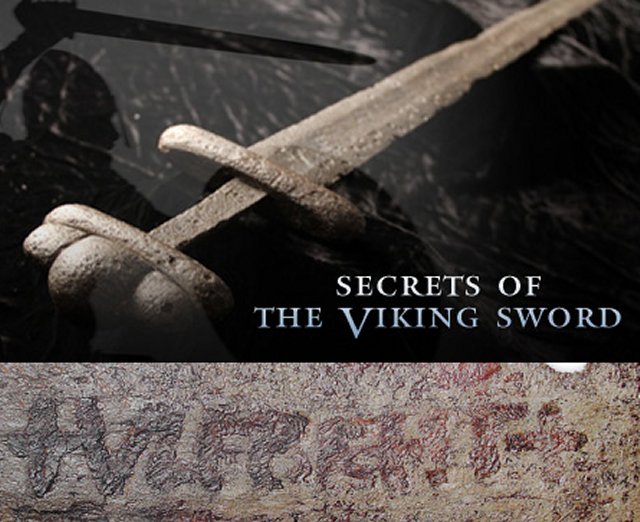MessageToEagle.com – Did Vikings possess superior ancient technology ahead of its time?
Can archaeologists solve the puzzle of this ancient Scandinavian mystery?
Whose name is inscribed on this enigmatic ancient sword?
We may think we know a lot about Vikings. They are often portrayed as a crude people that should be feared. What we tend to forget is that some of their ancient artifacts have remained a puzzle for years.
Among them we find the mysterious Ulfberht sword that was a very advanced weapon thousands of years of its time. Archaeologists have been trying to figure out how the Vikings could use such pure metal.
What made the Ulfberht blades so advanced?
While most Viking blades were found to have been composed of slag-ridden, low-carbon steel, these blades’ metal was comparable to the strength of modern steel. The mystery was how the Vikings created these blades while the rest of Europe was still making steel that could shatter like glass.
Up to now, about 170 Ulfberhts have been discovered and they are all dating from 800 to 1,000 A.D.
How they were created is therefore an enigma. In the process of forging iron, the ore must be heated to 3,000 degrees Fahrenheit to liquify, allowing the blacksmith to remove the impurities (called “slag”).
The Ulfberht’s combination of strength, lightness and flexibility was an advantage. Medieval blacksmiths in Europe didn’t make slag-free steel, because their fires weren’t hot enough to fully liquefy the iron. In modern times, metals are melted at temperatures over 3,000 degrees.
This separates out the slag and allows more carbon to be mixed in evenly. But in the Viking era, carbon could only be introduced incidentally, mainly through the coal in the fire, and the only way to remove the slag from the metal was to try to hammer out the impurities with each strike.
Of the thousands of European swords from the Middle Ages that have been found, all were thought to have been made from this inferior steel, until Dr Alan Williams, an archaeometallurgist and consultant to the Wallace Collection, the London museum which has one of the best assemblies of ancient weapons in the world analyzed the Ulfberht.
“The swords were far better than any other swords made, before or since, in Europe. And these must have been extraordinarily valuable to their contemporaries, because of their properties.
One or two swords I looked at seemed to be different. They were made of steel, which I’d never seen, before or since, in a medieval object. This seems to be a completely different material.
The first thing that strikes you is that there are none of these long, grey slag inclusions, which make the metal brittle. The uniformity is more like a modern steel than it is a medieval one. And it has got a carbon content of about three times as much as the medieval steel we looked at a moment ago. I thought it was very odd. I couldn’t think of a reason for it.
The material used was a novel material, not found anywhere else in Europe in the middle ages,” Dr. William says.
“The biggest mystery is where did they (the Vikings) get this raw material? We have no archaeological evidence of any crucible steel production in Europe until 800 years later,” Richard Furrer asks in the NOVA documentary.
Scientists suspect the metal came from the Middle East.
“The interesting thing is that the most Ulfbehrt swords are dated from exactly the same time when the Volga trade route was open, that is from the early 800s to the mid-1,000s.
I think it’s very likely that the steel that you find in the Ulfberht swords originated from Iran. I would guess that you bought it from friendly trading connections in Iran, paid with furs and other Nordic commodities, and took it back on your small ships that you used on the rivers,” says Fredrik Charpentier Ljungqvist, Secretary for the Centre of Medieval Studies at Stockholm University, Sweden.
The swords were inscribed with the signature “+ULFBERH+T,” but the origin of the name remains a mystery.
“Why they put this on, it’s…we don’t know. We are quite puzzled. But it might be because it was, they were making a statement: “This is the real deal. This is something of quality.” But Ulfbehrt is actually an enigma. We don’t know who Ulfbehrt was,” Professor Jon Anders Risvaag at Norwegian University of Science says.
The Vikings were among the fiercest warriors of all time. Yet only a select few carried the ultimate weapon of their era: the feared Ulfberht sword. Fashioned using a process that would remain unknown to the Vikings’ rivals for centuries, the Ulfberht was a revolutionary high-tech tool as well as a work of art. Considered one of the greatest swords ever made, it remains a fearsome weapon more than a millennium after it last saw battle. But how did Viking sword makers design and build the Ulfberht, and what was its role in history?
We have come one step closer unraveling the mystery of the enigmatic Ulfberht Sword, but we still do not possess complete knowledge about this ancient Viking artifact.
Copyright © MessageToEagle.com. All rights reserved. This material may not be published, broadcast, rewritten or redistributed in whole or part without the express written permission of MessageToEagle.com.
source: University of Stockholm

